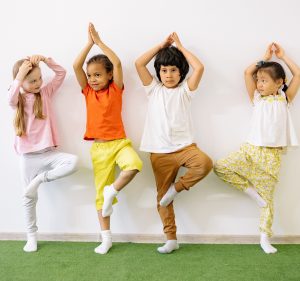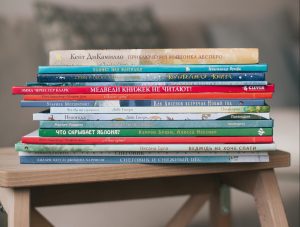
November is Adoption Awareness Month, and many adoptive families out there are hoping you’ll take this opportunity to teach your kids how to love our kids just a little bit better.
Our family is a particularly “conspicuous family,” as we are an interracial family (made up of white American parents with a Thai daughter). This has led to lots of questions—and some difficult experiences—for our little one over the past five years. So I’m writing this from the perspective of an adoptive mama – sharing lessons I hope you’ll teach your child (that I’m teaching mine too)!

There are so many simple ways we can work in conversations (and practical lessons) with our children that will open their minds and hearts, prevent hurtful interactions that make kids feel “othered”, and encourage inclusivity. Here are a few impactful concepts to work through with your kids:
1) We’re All Unique
Be a family that celebrates the things that make others unique! From our interests to our accents, our skin, hair, and eyes, or even the way we choose to dress—don’t overlook and dismiss these differences with your child. Point out the beautiful things that make people unique. Take every opportunity to answer your child’s questions and always consider differences thoughtfully. In our household we’ve discussed things like differently colored hair, tattoos, and piercings. We also have explained adaptive equipment for differently abled individuals, physical differences, religious/cultural head coverings, and other cultural attire. Children notice and wonder about these things. . . just as they notice different hair textures and styles, or all the beautiful shades of skin they see. Judging people or being “colorblind” isn’t what we’re after—we want our kids to see and appreciate all the unique ways each of us are beautiful and special!
Practical application:
- Let your children see you compliment people who look different than you do. The way we reinforce basic beauty standards impacts our kids deeply! This includes engaging with differently abled and/or neurodivergent children and adults, too. We all need more kind smiles, friendly waves, and thoughtful compliments!
2) “Different, Not Weird”
It’s human nature to have a reaction or opinion about things that seem “different” to us, but it can be very hurtful to call those things “weird.” Normalize the phrase “it’s not weird, it’s just different!” This applies to names, languages, clothing, aspects of one’s appearance, or even food that might be out of the norm for your family. These things are usually deeply meaningful to an adopted child, but they are also often ways they’re made to feel “othered.” It can really hurt when kids laugh at your name, the food you eat, or the way you talk. Create an atmosphere in your family where it’s cool to try new things and where differences can be appreciated!
Practical applications:
- Commit to a monthly family outing to visit different restaurants in town and try new foods together! Birmingham has so many amazing options for food from all over the world! (Be sure to try our family’s favorite Thai restaurant – Blue Pacific!) As you experience the unfamiliar flavors and textures, work on polite ways to express dislikes (like “no thank you,” “that’s not my favorite,” or “I didn’t really enjoy that,” versus “ew, gross”). As you try the new foods together, you might also learn a little bit about that country and culture as a family.
- Try to learn how to say a greeting in the language of a new adoptee, immigrant neighbor, or perhaps a friend who signs in ASL! If your child struggles, use that opportunity to teach them empathy. Remind them how brave (and difficult) it is to learn a second language!

3) Inclusion matters
Do your children only play with kids who look like them? Would they be welcoming to a child at school or at the park who looked different, spoke differently, or played differently? Nothing is more heartbreaking for a parent than to hear their child say, “Mama, no one will play with me!” Teach your child to always look for people who need a friend.
Practical applications:
- Kids learn by example. Model engagement for them with people who don’t look like you! This can be as simple as who you strike up conversations with on the playground or in line at the store. Also, teach your kids to be creative in the ways they include others! Even if language or abilities are barriers, there are still creative ways to play together!
- Diversify their toys & books (this will also help with points #1 and #2 above). Playing with toys that don’t all look the same and reading stories that feature children of other ethnicities or cultures will help normalize diversity/inclusion. (Your local librarian can recommend some great books!) If your child’s imagination is full of beautifully unique characters, their hearts will be more open to seeking diverse friendships too!
4) Curiosity has limits
While natural curiosity is understandable, it’s good to teach your children healthy boundaries. Adoptees don’t have to answer questions or share parts of their story they’d rather keep private. Not all adoptees feel connected to their first culture/language or want to discuss their past, though some do. Allow them to share as much or little as they’d like to, and teach your children to respect their limits. Remember that every adoption includes trauma and loss. Practice having gentleness and empathy with your kids.
Practical applications:
- Have conversations at home with your child about adoption. This is a great time to answer questions and explain things in simple, affirming terms. (Do explain that adoption is one way to make a family. Don’t include narratives that make adoptees out as unwanted, or ones that portray adoptive parents as “saving” or “rescuing” their kids.) Make sure that your children know that the fact that a child is adopted should never be used as a joke or a way or exclude anyone.
- If you’re parenting teens or tweens, you may be able to discuss nonverbal communication. For example: “Pay attention to your friend’s expressions and body language. Does it seem like they don’t want to talk about this subject? It’s great to be interested in someone and to want to get to know them better, but it’s also kind to notice if someone is uncomfortable. You could say, ‘We don’t have to talk about this if you don’t want to!'” You might also teach an older child to ask questions with a disclaimer like, “I’d love to know more about you, but you don’t have to talk about anything that makes you uncomfortable.”
5) Teach affirming language
All parents are “real parents”. All siblings are “real siblings”.
Normalize the fact that not all families look the same, but that doesn’t mean they aren’t “real.” First (biological) families are real. Foster families are real. Adoptive families are real. (This is a lesson that can also be applicable for single parents, divorced/remarried families, children being raised by other family members, interracial families, etc.! It’s okay if our families look different—love is what matters most!)
Practical application:
Check out books like The Great Big Book of Families, We Belong Together, The Family Book, or My Family, Your Family. Point out all the beautifully different families in these books, and/or in your own social circles!












